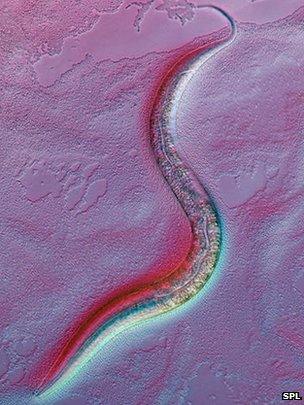Virtual worm project wriggles into life
- Published

The nematode worm Caenorhabditis elegans is one of the most widely studied creatures on Earth
Soon you could have an artificial creature living in your web browser.
Programmers and scientists have joined together to try to create a comprehensive computer model of the Caenorhabditis elegans nematode worm.
The cellular model of the worm will help to understand how its complex behaviour emerges from the interaction of those basic building blocks.
The project members hope success will spur the creation of other biologically accurate virtual creatures.
Caenorhabditis elegans is one of the most widely studied creatures and was the first multicelled organism to have its entire genome mapped.
Detailed simulation
Despite this, and the huge amount of data gathered about its lifestyle and biology, big questions remain about how and why the worm does what it does.
The Open Worm project will produce a detailed simulation that models each of its 1,000 or so cells in an attempt to answer these questions by producing a virtual worm that acts exactly like its real world counterparts.
The worm developers hope that modelling the creature in exacting detail will cause more complex behaviour, such as feeding, finding mates and avoiding predators, to emerge spontaneously.
Scrutinise and share
"It's a pretty massive undertaking," John Hurliman, one of the worm development team, told the New World Notes blog, external. Mr Hurliman said the Open Worm project had already produced an early demo that shows five muscle segments of the worm's body swimming in water.
The swimming movement is generated by signals from virtual nerve cells that cause the simulated muscles to flex, propelling the worm forward. Despite the early success, it would be months before people would be able to download the virtual creature and see it move for themselves, said Mr Hurliman.
Code produced during the project will be openly available for others to scrutinise and share. The team hopes other people will use the code to start development of other artificial life forms.
- Published31 July 2012
- Published23 January 2013
- Published6 July 2012
- Published23 July 2012